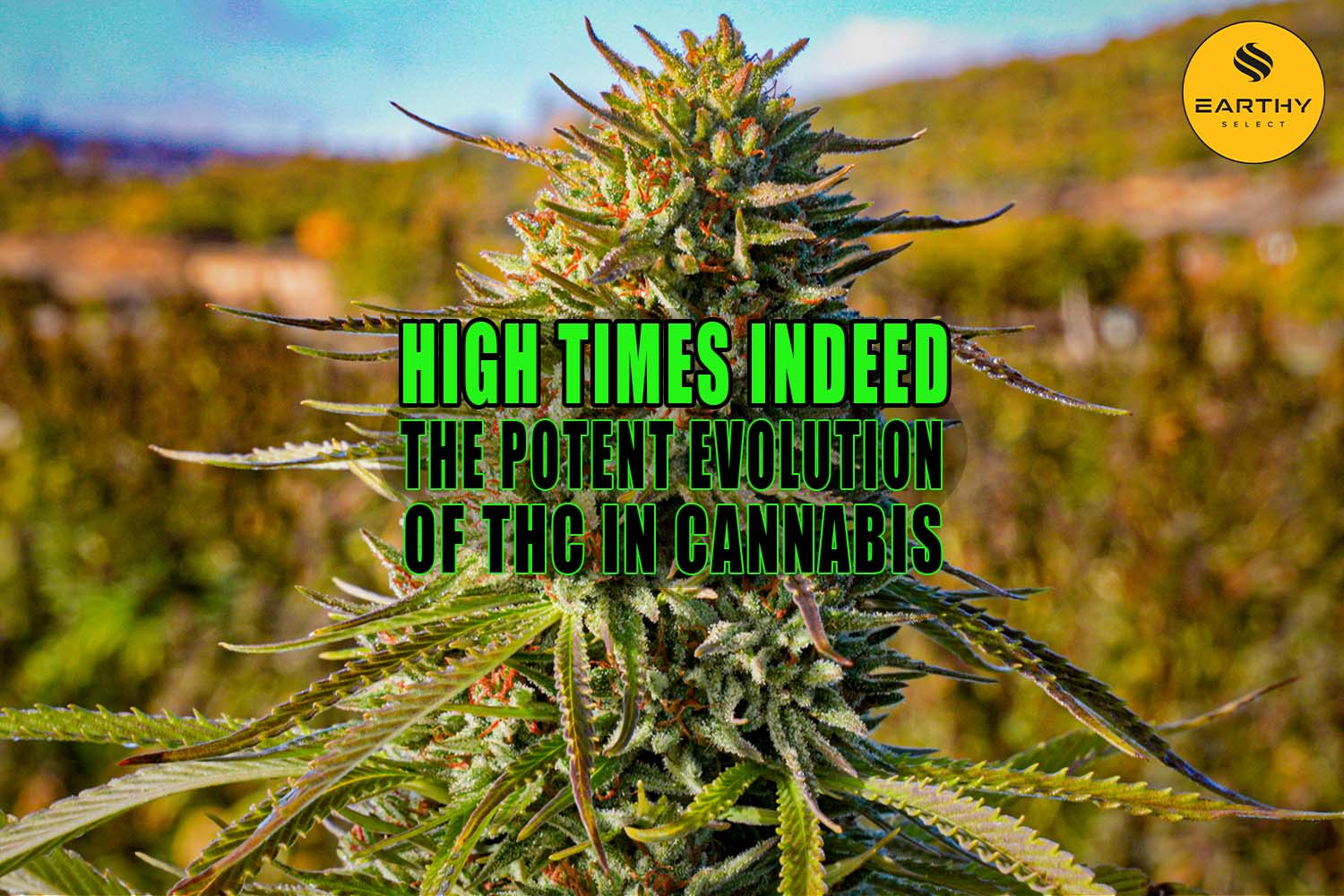High Times Indeed: Tracing the Potent Evolution of THC in Cannabis
Cannabis, a plant cultivated and used by humans for millennia, has evolved significantly, particularly in its levels of THC, the psychoactive compound responsible for its mind-altering effects. From the ancient cannabis plants used for fiber and medicine to the potent strains of today, the journey of THC’s development reflects cannabis’s deep history and global impact [1]. Here, we’ll trace the evolution of the cannabis plant, examining how modern cannabis compares to its ancestors and how its potency affects both recreational and medicinal use.
The origins of cannabis: a global history
Cannabis has been cultivated for thousands of years. Interestingly, archaeological evidence suggests that Cannabis sativa originated in Central Asia, particularly in the regions surrounding present-day Mongolia. Inhabitants there used Cannabis sativa plants for hemp fiber, hemp seeds, and oils, making them some of the first cultivated plants in human history. However, this ancient cannabis contained only trace amounts of THC, and its primary uses were industrial and medicinal [1].
The Middle East, particularly India, played a crucial role in the development of psychoactive cannabis use. Notably, the culture used Indian hemp (as it was known) mostly in religious and spiritual rituals. Later, cannabis smoking, specifically marijuana, gained popularity for its psychoactive properties. As such, the resin from cannabis plants, particularly from Cannabis indica, found its way into preparations such as hashish and other cannabis extracts. Unlike its counterpart Cannabis sativa, Cannabis indica had higher THC levels than its fiber-rich cousin [2].
The Ultimate Guide to THCa Flower
Evolution of THC research: exploring the psychoactive compound
THC, or tetrahydrocannabinol, is the primary psychoactive compound in cannabis responsible for the “high” associated with cannabis use. Notably, this compound interacts with cannabinoid receptors in the brain, triggering psychoactive effects such as euphoria, altered perceptions, and relaxation. These receptors are part of the endocannabinoid system (ECS), which plays a significant role in regulating mood, memory, and pain perception [3].
Cannabis research in the 20th century, particularly work done by Raphael Mechoulam in the 1960s, identified THC as the component of cannabis responsible for its psychoactive effects. As a result, other researchers discovered cannabinoid receptors, further deepening the scientific understanding of how cannabis affects the human brain and body [4].
Is Hemp-Derived Delta-9 THC Legal?
Evolution of THC in modern cannabis
Over the past few decades, the cannabis plant has undergone a significant transformation. For example, through selective breeding, growers have developed strains of cannabis with much higher THC concentrations than wild hemp or early cultivated varieties. In the past, THC levels in cannabis were typically around 1-3%. However, modern marijuana strains now regularly contain THC levels as high as 20-30%, with some hybrid strains even surpassing that threshold [5].
This shift in cannabis potency stems largely from intentional cannabis cultivation. Scientifically speaking, selective breeding techniques have allowed growers to manipulate the cannabis germplasm resources, enhancing the psychoactive properties of female plants. Cannabis inflorescence, the flowering part of the plant, retains the concentrations of THC, which breeders can manipulate [5].
While recreational cannabis users often seek out these high-THC strains for their potent psychoactive effects, medical cannabis advocates have also shown interest in the therapeutic potential of high-potency THC. For example, some researchers associate high-THC strains with potentially beneficial cannabis therapeutics for medical conditions, such as chronic pain, nausea associated with chemotherapy, and appetite stimulation in AIDS patients [6]. However, the FDA has only approved one cannabis-derived drug product, Epidiolex, for a rare form of epilepsy, and three synthetic cannabis-related drug products, Marinol (dronabinol), Syndros (dronabinol), and Cesamet (nabilone) for appetite-related conditions [7].
The Intersection of Cannabis and Technology
Cannabis cultivation and the rise of potency
The evolution of THC in cannabis plants comes from cutting-edge cultivation techniques. Indeed, modern cannabis growers use sophisticated methods, including hydroponics and indoor growing, to control the environment and maximize THC production. Also, these techniques allow growers to manipulate factors like light, humidity, and nutrients, all of which affect cannabinoid production [8].
How to Grow Weed: A Beginner’s Guide to Cannabis Cultivation
Genetic evidence shows that the cannabis plant, being dioecious (having distinct male and female plants), can enjoy selective breeding to enhance specific traits. For example, dioecious plants like cannabis allow breeders to favor high-THC female plants by eliminating male plants, which do not produce the desired THC-rich flowers. Ultimately, this form of selective breeding has led to the rise of strains like Cannabis sativa and Cannabis indica hybrids with heightened THC content [8]. Hence, today’s cannabis often has much higher THC levels than its ancient predecessors.
Wholesale THCa Flower Strains: What to Look For
Medicinal cannabis and the role of THC
Though many associate THC with recreational uses, it also plays a critical role in the medicinal cannabis field. For instance, healthcare professionals sometimes suggest medical cannabis for various ailments, including chronic pain and anxiety. However, some experts urge caution as outcomes for these conditions have not been sufficiently studied [6].
While medical marijuana often focuses on THC, other cannabinoid compounds, such as CBD (cannabidiol), have also gained attention for their wellness potential. Unlike THC, CBD does not have psychoactive effects, making it popular in treatments where a “high” is undesirable. Also, cannabis preparations with a balanced THC-to-CBD ratio appeal to many for their potential to provide wellness benefits without significant psychoactivity. Hence, the evolution of THC goes hand-in-hand with the evolution of CBD [9].
The 2024 Farm Bill: What Consumers and Businesses Can Expect
Potent cannabis products from Earthy Select
Earthy Select offers a wealth of popular cannabis strains and innovative products. Browse an array of top-quality cannabis treats for recreation and wellness:
- THCa Flower Eighths, Quarters, Pounds: Containing abundant cannabinoids and terpenes, Earthy Select’s potent THCa Flower harnesses the plant’s full potential.
- Vape Products: Earthy Select’s Delta-8 THC premium vape cartridges and disposable vape pens feature a rich blend of cannabis terpenes for optimal flavor and effects.
- Cannabis Edibles: Delta-8, Delta-9, and Delta-10 Gummies are potent and made with all-natural ingredients. They offer an easy and delicious cannabis experience, and users report feelings of relaxation, euphoria, increased creativity, and pleasure.
Earthy Select THCa concentrates:
- Bubble Hash: Made through an ice-water extraction, this potent THCa hash satisfies the most discerning of cannabis concentrate connoisseurs.
- Diamonds: These sparkling THCa diamonds pack a full gram of concentrated THCa and .3 grams of live resin CBD sauce, terpenes, and other minor cannabinoids. 99.9% THCa!
- Live Rosin: Enthusiasts love Earthy Select’s powerful THCa rosin. Extracted from trichome-rich cannabis plants, this buttery treat is pure, potent, and flavorful.
Legalization and its impact on THC levels
The legalization of cannabis in several parts of the world, particularly in North America, has driven demand for more potent recreational cannabis products. Hence, as legal markets develop, the focus has shifted toward higher THC strains, primarily to satisfy consumer demand. For example, in states like California and Colorado, many cannabis enthusiasts enjoy potent strains specifically bred to contain high THC levels [10].
However, the rise in THC potency has also raised concerns about drug abuse and the potential negative health effects of recreational drugs. For instance, some studies have suggested that excessive use of high-THC cannabis can lead to issues such as dependency, cognitive impairment, and mental health disorders. The modern emphasis on potent cannabis strains has led to a growing discussion within the scientific community about the risks associated with high THC consumption [10].
The future of THC in cannabis
As cannabis continues to evolve, both through natural selection and human intervention, the future of THC in cannabis looks complex. For example, some researchers and breeders have turned their attention back to hemp research. In other words, many scientists have begun to focus on creating strains that have lower THC and higher CBD content. These efforts are in response to both consumer demand and medical interest in cannabinoids beyond THC [11].
Also, the development of synthetic cannabinoids and synthetic THC further complicates the landscape. Notably, these lab-created compounds mimic the effects of natural THC and are sometimes used in drug testing and clinical studies. However, synthetic THC products may have adverse health effects, leading to regulatory challenges and public health concerns [12].
In addition to synthetic options, cannabis breeders increasingly explore ways to cultivate plants with more balanced or even customizable cannabinoid profiles. Interestingly, these strains may offer the therapeutic benefits of cannabinoids without the strong psychoactive effects of traditional THC-rich cannabis. Advances in the study of plant physiology will likely continue to shape the future of cannabis cultivation [13].
Key takeaway: evolution of THC in cannabis
Both natural processes and human cultivation have shaped the evolution of THC in cannabis. From ancient cannabis plants used for fiber and food to the high-potency strains we see today, the journey of THC has been a remarkable one. But, as cannabis research continues and the industry matures, we likely will see further innovation in cannabis breeding with a focus on creating strains that offer a range of effects [13].
While THC remains the most well-known compound in cannabis, it is only one piece of the puzzle. Undoubtedly, as science unlocks more about the complex interactions between cannabinoids, the future of cannabis holds exciting possibilities for both therapeutic and recreational use.
Visit Earthy Select for potent Delta-8, Delta-9, Delta-10, and THCa products!
Medical Disclaimer / Legal Disclaimer – Information is provided for educational purposes. It does not and is not intended to constitute legal advice or medical advice. We attempt to be accurate and up-to-date, but the legality of cannabinoids and the science of cannabis are evolving. The author is neither a legal professional nor a medical expert. Before buying or using any products, you should check with your local authorities and medical providers.
References
- The Origins of Cannabis Smoking: Marijuana Use in the First Millennium BC
- Indica, Sativa or Hybrid? The Origin and End of Cannabis Categorizing
- An Introduction to the Ecannabinoid System
- Dr. Raphael Mechoulam, Cannabis and Cannabinoids Research Pioneer
- Challenges and Potentials of New Breeding Techniques in Cannabis Sativa
- Medical Marijuana
- FDA and Cannabis: Research and Drug Approval Process
- Selective Breeding Techniques for Cannabis Cultivators
- Cannabidiol (CBD): What We Know and What We Don’t Know
- High-Potency Pot Market Worth Billions Draws Scrutiny
- The Ultimate Guide to Understanding THC & CBD Ratios
- Synthetic Cannabinoids
- FDA’s 50 Years of Experience with Cannabis Research Helping to Support Tomorrow’s Cannabis Drug Development
- Changes in Cannabis Potency over the Last Two Decades
- The Problem with the Current High Potency THC Marijuana
Frequently Asked Questions
How has the THC content in cannabis changed over time?
The THC content in cannabis has significantly increased due to selective breeding and advanced cultivation techniques. For example, traditional cannabis strains once contained around 1-3% THC, while modern strains often contain 20-30% or more [14].
What factors contributed to the rise in THC levels in cannabis?
The rise in THC levels stems primarily from selective breeding. For example, growers focus on producing high-THC strains, and along with advances in cultivation techniques, they have precise control over the plant’s environment [14].
Does higher THC content make cannabis more dangerous?




